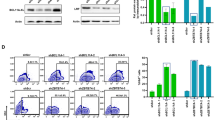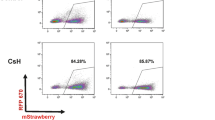Abstract
We have developed a retroviral vector coexpressing the multidrug-resistance 1 (MDR1) cDNA for inducing cancer drug resistance and the truncated version of the low-affinity nerve growth factor receptor (ΔLNGFR) for cell-surface marking of transduced cells. The vector is based on the FMEV backbone which mediates high levels of gene expression in hematopoietic cells. To achieve optimal expression levels of both cDNAs, untranslated regions from MDR1 and ΔLNGFR were removed and three different connections were tested: retroviral splice signals, an internal ribosomal entry site (IRES) from encephalomyocarditis virus, and an internal promoter from the chicken β-actin gene. As determined by two-color flow cytometry, the best correlation of the expression of both cDNAs was obtained using the vector SF1mSδ which utilized retroviral splice signals for co-expression. Simultaneous expression of both cDNAs at the single cell level was also shown by confocal laser microscopy. Lymphoid and hematopoietic progenitor cells, including primary human CD34+ cells, transduced with SF1mSδ acquired dominant multidrug resistance. Transduced primary CD34+ cells could be enriched in vitro based on expression of ΔLNGFR, avoiding exposure to cytostatic agents. Thus, monitoring the selection of chemotherapy-resistant cells and analyzing their biological properties may be alleviated, both in vitro and in vivo.
This is a preview of subscription content, access via your institution
Access options
Subscribe to this journal
Receive 12 print issues and online access
$259.00 per year
only $21.58 per issue
Buy this article
- Purchase on Springer Link
- Instant access to full article PDF
Prices may be subject to local taxes which are calculated during checkout






Similar content being viewed by others
References
Gottesman MM, Pastan I . Biochemistry of multidrug resistance mediated by the multidrug transporter Ann Rev Biochem 1993 62: 385–427
Baum C et al. Gene transfer and transgene expression in hematopoietic cells. In: Strauss M, Barranger JA (eds) Concepts in Gene Therapy DeGruyter: Berlin 1997 pp 233–266
Hanania EG et al. Results of MDR-1 vector modification trial indicate that granulocyte/macrophage colony-forming unit cells do not contribute to post-transplant hematopoietic recovery following intensive systemic therapy Proc Natl Acad Sci USA 1996 93: 15346–15351
Devereux S et al. Feasibility of multidrug resistance (MDR-1) gene transfer in patients undergoing high-dose therapy and peripheral blood stem cell transplantation for lymphoma Gene Therapy 1997 5: 403–408
Hesdorffer C et al. Phase I trial of retroviral-mediated transfer of the human MDR1 gene as marrow chemoprotection in patients undergoing high-dose chemotherapy and autologous stem-cell transplantation J Clin Oncol 1998 16: 165–172
Baum C et al. Novel retroviral vectors for efficient expression of the multidrug resistance (mdr-1) gene in early hematopoietic cells J Virol 1995 69: 7541–7547
Eckert HG et al. High-dose multidrug resistance in primary human hematopoietic progenitor cells transduced with optimized retroviral vectors Blood 1996 88: 3407–3415
Hildinger M et al. Dominant selection of hematopoietic progenitor cells with retroviral MDR1-coexpression vectors Hum Gene Ther 1998 9: 33–42
Fehse B et al. Impact of a new generation of gene transfer markers on gene therapy Gene Therapy 1998 5: 429–430
Magni M et al. Induction of cyclophosphamide-resistance by aldehyde-dehydrogenase gene transfer Blood 1996 87: 1097–1103
Zhao SC et al. Post-transplant methotrexate administration leads to improved curability of mice bearing a mammary tumor transplanted with marrow transduced with a mutant human dihydrofolate reductase cDNA Hum Gene Ther 1997 8: 903–909
Scheffer GL et al. The drug resistance-related protein LRP is the human major vault protein Nature Med 1995 6: 578–582
Jelinék J et al. Long-term protection of hematopoiesis against cytotoxic side-effects of multiple doses of nitrosoureas by retrovirus-mediated expression of O6-alkylguanine-DNA-alkyltransferase Blood 1996 87: 1957–1961
Rappa G, Lorico A, Flavell RA, Sartorelli AC . Evidence that the multidrug resistance protein (MRP) functions as a co-transporter of glutathione and natural product toxins Cancer Res 1997 57: 5232–5237
Goodell MA et al. Dye efflux studies suggest that hematopoietic stem cells expressing low or undetectable levels of CD34 antigen exist in multiple species Nature Med 1997 3: 1337–1345
Kim M, Cooper DD, Hayes SF, Spangrude GJ . Rhodamine-123 staining in hematopoietic stem cells of young mice indicates mitochondrial activation rather than dye efflux Blood 1998 91: 4106–4117
Pawliuk R, Eaves CJ, Humphries RK . Sustained high-level reconstitution of the hematopoietic system by preselected hematopoietic cells expressing a transduced cell-surface antigen Hum Gene Ther 1997 8: 1595–1604
Fehse B et al. Selective immunoaffinity-based enrichment of CD34+ cells transduced with retroviral vectors containing an intracytoplasmatically truncated version of the human low-affinity nerve growth factor receptor (ΔLNGFR) gene Hum Gene Ther 1997 8: 1815–1824
Ruggieri L et al. Cell-surface marking of CD(34+)-restricted phenotypes of human hematopoietic progenitor cells by retrovirus-mediated gene transfer Hum Gene Ther 1997 8: 1611–1623
Hildinger M et al. FMEV vectors: both retroviral long terminal repeat and leader are important for high expression in hematopoietic cells Gene Therapy 1998 5: 1575–1579
Baum C et al. Cis-elements of Friend-SFFVp: role in disease induction and utility in retroviral vectors Acta Haematol 1998 99: 156–164
Ghattas IR, Sanes JR, Majors JE . The encephalomyocarditis virus internal ribosomal entry site allows efficient coexpression of two genes from a recombinant provirus in cultered cells Mol Cell Biol 1991 11: 5848–5859
Quitschke WW, Lin ZY, DePonti-Zilli L, Paterson BM . Beta actin promoter. High levels of transcription depend upon a CCAAT binding factor J Biol Chem 1989 264: 9539–9546
Sorrentino BP, McDonagh KT, Woods D, Orlic D . Expression of retroviral vectors containing the human multidrug resistance 1 cDNA in hematopoietic cells of transplanted mice Blood 1995 86: 491–501
Schilz AJ et al. High efficiency gene transfer to human hematopoietic SCID-repopulating cells under serum-free conditions Blood 1998 92: 3163–3171
Sorrentino BP et al. Selection of drug-resistant bone marrow cells in vivo after retroviral transfer of human MDR1 Science 1992 257: 99–103
Podda S et al. Transfer and expression of the human multiple drug resistance gene into live mice Proc Natl Acad Sci USA 1992 89: 9676–9680
Conneally E, Eaves CJ, Humphries RK . Efficient retroviral-mediated gene transfer to human cord blood stem cells with in vivo repopulating potential Blood 1998 91: 3487–3493
Bunting KD et al. Transduction of murine bone marrow cells with an MDR1 vector enables ex vivo stem cell expansion, but these expanded grafts cause a myeloproliferative syndrome in transplanted mice Blood 1998 92: 2269–2279
Aran JM, Gottesman MM, Pastan I . Drug-selected coexpression of human glucocerebrosidase and P-glycoprotein using a bicistronic vector Proc Natl Acad Sci USA 1994 91: 3176–3180
Borman AM, Le Mercier P, Girard M, Kean KM . Comparison of picornaviral IRES-driven internal initiation of translation in cultured cells of different origins Nucleic Acids Res 1997 25: 925–932
Emmerman M, Temin HM . Genes with promoters in retrovirus vectors can be independently suppressed by an epigenetic mechanism Cell 1984 39: 449–467
Acknowledgements
BF, AZ, WO and CB were supported by a grant of the Bundesministerium für Bildung und Forschung (O1KV 9530, 9531, 9811), MH by a grant of the José Carreras Leukemia Fund. We are grateful to B Koch, Boehringer Mannheim, Germany, for providing the biotinylated antibody directed against ΔLNGFR. The Heinrich-Pette-Institut is financially supported by the Freie und Hansestadt Hamburg and the Bundesministerium für Gesundheit, Germany.
Author information
Authors and Affiliations
Rights and permissions
About this article
Cite this article
Hildinger, M., Schilz, A., Eckert, HG. et al. Bicistronic retroviral vectors for combining myeloprotection with cell-surface marking. Gene Ther 6, 1222–1230 (1999). https://doi.org/10.1038/sj.gt.3300942
Received:
Accepted:
Published:
Issue Date:
DOI: https://doi.org/10.1038/sj.gt.3300942
Keywords
This article is cited by
-
Efficient in vivo regulation of cytidine deaminase expression in the haematopoietic system using a doxycycline-inducible lentiviral vector system
Gene Therapy (2013)
-
Bidirectional promoter interference between two widely used internal heterologous promoters in a late-generation lentiviral construct
Gene Therapy (2008)
-
Towards hematopoietic stem cell-mediated protection against infection with human immunodeficiency virus
Gene Therapy (2006)
-
Rapid detection of retroviral vector integration sites in colony-forming human peripheral blood progenitor cells using PCR with arbitrary primers
Gene Therapy (2003)
-
Improved post-transcriptional processing of an MDR1 retrovirus elevates expression of multidrug resistance in primary human hematopoietic cells
Gene Therapy (2001)



